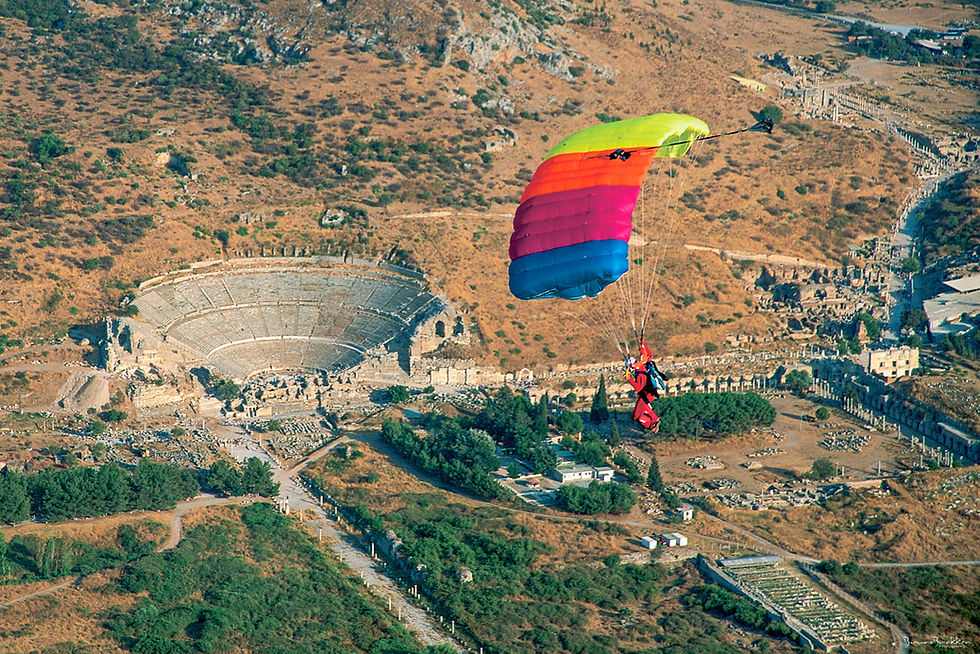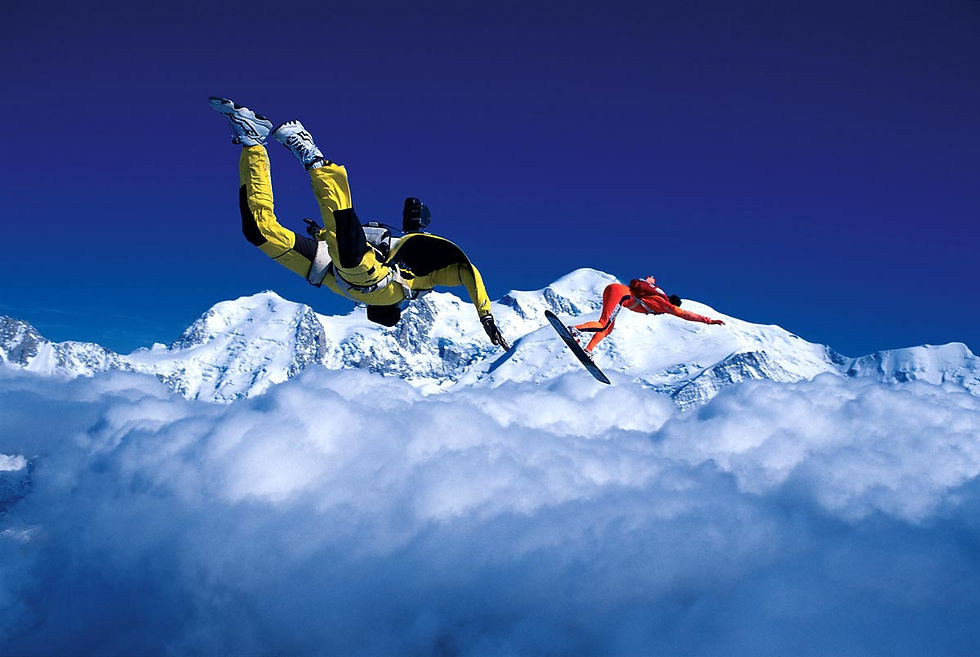SKYDIVING COMPETITION III
- Support Air International

- Feb 9, 2021
- 5 min read
Updated: Feb 18, 2021
As the FAI Skydiving Commission approached the turn of the decade from the 80s to the 90s, the young air sport it governed since the 50s had started to change. Roland Hilfiker writes about these changes in the third installment of SKYDIVING COMPETITION OVER TIME.

Relative Work and Canopy Relative Work, first considered anti-establishment disciplines with a narrow Western appeal, had consolidated themselves. Their championships started to draw nearly as broad an international participation as those in the classic disciplines, and they suddenly saw countries like the Soviet Union or the People’s Republic of China on the verge of breaking into the medal ranks.
Furthermore, the rules in all discipline stipulated that state-of-the-art electronic equipment be used to evaluate the athletes’ performances and to produce fair results. “Automatic Measuring Devices” determining the deviations from the dead center in Accuracy Landing and powerful ground-to-air cameras zooming in on athletes thousands of meters up, in freefall or under canopy, started to make competitive events more compelling for those watching.
Looking at parachuting/skydiving alongside waterskiing – an Olympic Demonstration Sport in Munich 1972 also depending on means of mechanical propulsion to have athletes perform, and of an overall appeal to similar demographics – one could not help but conclude: it had everything required to make it to Barcelona 1992. Everything EXCEPT for the ultimate conviction and the willingness to adapt further to the implicit rules of Olympism, those calling for a sport to draw crowds at the gate, to bring millions to watch it on TV, and to be a marketable asset overall.
When I asked Eilif Ness, the President of the ISC from 1991 until 1993 and of the FAI from 1994 through 2000, how he perceived the attitudes of ISC delegates and subcommittee members at the time, he was as explicit as always. We remember that he described the 70s' debate over the emergence of “Sequential Formation Skydiving” as a power struggle between establishment and rebels.
"What followed was a decade of refinement – and of gradually developing elitism," Ness sums up the 80s, "with the latter manifesting itself in the inevitable navel gazing and the nearly total reluctance to consider change."
"When we started the process, our guiding principle was to ask the jumpers what they wanted," he reminisces. "But then we learned the hard way that one cannot expect the top competitors to truly innovate." This had a major impact on the candidature file for parachuting/skydiving at the Games. What had been submitted to the Barcelona Organizing Committee as "A Modern Air Sport's Bid to Become an Olympic Demonstration Sport" was not the blueprint to appealing and compact competitions in parachuting/skydiving, but the protocols to complex events held under restrictive rules – and with only limited visibility.
In the chapter "The Dream That Never Came True’" of High Flyers: A Century of Sporting Achievements in the Air*, Ness writes about the outcome of the first Olympic campaign. “Unfortunately, in Barcelona, these efforts were not to bear fruit,” he sums them up and praises the man at the helm as well as the one in the engine room: FAI Olympic Coordinating Committee (OCC) Chair Uwe Beckmann and FAI Secretary General Cenek Kepak.

Beckmann was very explicit in his report to the 1992 FAI General Conference: “I believe air sports are not ready for the Olympic Games; they have not yet fully understood what is expected of a modern sport in the future. For far too long, our sports have only cared about themselves, and have been neglecting what was happening outside their splendid isolation.” He went on to suggest that new ideas be developed with a view to the future, and that changes and adjustments be made to establish media presence and attract commercial sponsorships.
Some of the milestones attained in the past were to make that possible. The Seoul 1988 Skydiving Exhibition and a series of similar showcases on the fringes of the Barcelona Games had certainly helped to put parachuting/skydiving on the radar of world sports.
And as everybody knows, new ideas never were in short supply in this community! Virtually every skydiver seems blessed with boundless imagination and creativity.
Deanna Kent and Mike “Michigan” Sandberg used theirs to come up with a new freefall discipline: one transgressing the borders between sport and art. Freestyle was born.
Skysurfing, a discipline combining the dynamics of surfing or snowboarding with unique celestial aesthetics, was the brainchild of French skydivers, the ingenious Patrick de Gayardon† first and foremost.
Freeflying, which evolved from taking freestyle to more extreme attitudes and radical spatial orientation, was developed by an international group of skydivers around Olav Zipser.
Add another pioneer: one with entrepreneurial vision and the television savvy to match. Enter Pete McKeeman, a producer/cameraman from Texas with his own background in skydiving. He created a governing body, the World Freestyle Federation, and an overarching brand – “SkyBlazin’” – for the new disciplines. And that was just for starters.

I had the fortune to host the 1993 World “SkyBlazin’” Championships at SKYDIVE EMPURIABRAVA jointly with McKeemann. I observed first-hand that his pragmatic approach of combining dramatic disciplines with high production standards generated solid exposure – which in turn helped to land quite a few sponsorships. From there, McKeeman went on to take charge of freeflying and skysurfing at the ESPN X-Games and established a Pro Tour. As per information provided by him, over a period of five years, he awarded prize money of 400,000 US$ to athletes competing in his events.
Authoring rules in the most abridged formats, enforcing them with the lightest of infrastructure, and subjecting them to overriding media requirements, all that was the prerogative of commercial organizers like ESPN. It was not something that would have allowed for a copy-paste by an organization that had to share the governance over its events between a multitude of stakeholders – and to adhere to a cumbersome process in doing so. That is one of the reasons that freestyle, freeflying and skysurf had to wait several more years before world championships were held under the auspices of the FAI.

Meanwhile, the activities continued on the public relations front. Forever the showstopper in Olympic pageantry, skydiving was picked once more to feature in the Lillehammer 1994 Winter Games coverage. Skysurfers and skydivers around Norwegian ISC delegate Pål Bergan were filmed by Norman Kent as they emulated winter sports in a high-impact opening sequence to the international broadcast of the Opening Ceremony.
At the same time, the FAI submitted its second Olympic bid dossier for parachuting/skydiving, not as a Demonstration Sport, that status had been abolished after Barcelona, but as a full-fledged medal sport on the program of Sydney 2000. The first recipients of the glossy brochure, which OCC chair Uwe Beckmann had again paid for out of his own pocket, were the members of the IOC Program Commission. All vagueness had disappeared from the document, as FAI set the global participation in the sport above the minima stipulated in the Olympic Charter: over 500,000 athletes in 78 member countries. It was just as specific on the events it proposed – only two, Accuracy Landing and 4-Way Formation Skydiving – as well as on the contingents of athletes, officials and the competition staff.
On the technical side, the Formation Skydiving Subcommittee had worked on the design of a 4-way event that would befit the Olympics better than the one conducted under standard rules. The exit was neutralized, with a star as first formation held for up to five seconds and without scoring, and the randomly drawn sequence was performed within a working time of only 15 seconds.
The event format was tested as the “Olympic Challenge” during the 1994 World Cup of Formation Skydiving in Empuriabrava. The live transmission of the jumps from 1,800 meters was as dramatic as ever. And the efforts to provide spectators with basic information on the object of the contest made a knowledgable and appreciative crowd out of whuffos.
* 1905 – 2005 High Flyers: A Century of Sporting Achievements in the Air, Pierre Morath (Eilif Ness); FAI 2005







Commenti